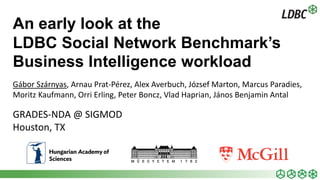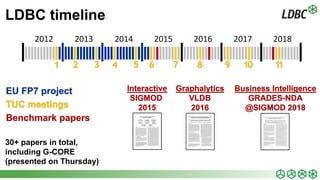An early look at the LDBC Social Network Benchmark's Business Intelligence workload
- 1. An early look at the LDBC Social Network BenchmarkŌĆÖs Business Intelligence workload G├Ībor Sz├Īrnyas, Arnau Prat-P├®rez, Alex Averbuch, J├│zsef Marton, Marcus Paradies, Moritz Kaufmann, Orri Erling, Peter Boncz, Vlad Haprian, J├Īnos Benjamin Antal GRADES-NDA @ SIGMOD Houston, TX
- 2. 2 Linked Data Benchmark Council LDBC is a non-profit organization dedicated to establishing benchmarks, benchmark practices and benchmark results for graph data management SW. LDBCŌĆÖs Social Network Benchmark is an industrial and academic initiative, formed by principal actors in the field of graph-like data management.
- 3. 3 LDBC timeline 2012 2013 2014 2015 2016 2017 2018 30+ papers in total, including G-CORE (presented on Thursday)
- 4. 4 Graph processing landscape Interactive Graphalytics BI local queries global queries computations
- 5. 5 BI global queries Graph processing landscape Interactive Graphalytics local queries computations Example: ŌĆ£Recently liked by friendsŌĆØ MATCH (u:User {id: $uID})-[:FRIEND]-(f:User)-[l:LIKES]->(p:Post) RETURN f, p ORDER BY l.timestamp DESC LIMIT 10 frequent upd.limited data
- 6. 6 Graph processing landscape Interactive Graphalytics local queries computations BI global queries frequent upd.limited data Example: ŌĆ£One-sided friendshipsŌĆØ MATCH (u1:User)-[:FRIEND]-(u2:User)-[l:LIKES]->(p:Post), (u1)-[:AUTHOR_OF]->(p) WITH u1, u2, count(l) AS likes WHERE likes > 10 AND NOT (u1)-[:LIKES]->(:Post)<-[:AUTHOR_OF]-(u2) RETURN u1, u2 lots of data infreq. upd.
- 7. 7 Graph processing landscape Interactive Graphalytics BI local queries global queries computations frequent upd.limited data lots of data infreq. upd. Example: ŌĆ£Find the most central individuals.ŌĆØ BFS breadth-first search LCC local clustering coefficient PR PageRank SSSP single-source shortest path CDLP community detection by label propagation WCC weakly connected components all data no upd.
- 8. 8 Graph processing landscape all data no upd. lots of upd.limited data lots of data few upd. Interactive Graphalytics BI local queries global queries computations
- 9. 9 Business Intelligence amount of data accessed expectedexecutiontime Interactive LDBC benchmarks at a glance Graphalytics
- 10. 10 Business Intelligence amount of data accessed expectedexecutiontime Interactive LDBC benchmarks at a glance Graphalytics Social Network Benchmark
- 11. 11 Social network graph DATAGEN: ŌĆó Generate realistic graphs ŌĆó Multiple scale factors (SFs) Nodes: ŌĆó Collection attributes ŌĆó Type inheritance Edges: ŌĆó With attributes ŌĆó Edges between similar nodes ŌĆó Network of Persons ŌĆó Reply tree of Posts/Comments
- 12. 12 Business Intelligence amount of data accessed expectedexecutiontime Interactive LDBC benchmarks at a glance Graphalytics
- 14. 14 design starts here
- 15. 15 Choke points ŌĆó = a challenging aspect of query processing, a well-chosen difficulty ŌĆó Allows systematic benchmark design Peter Boncz, Thomas Neumann, Orri Erling, TPC-H Analyzed: Hidden Messages and Lessons Learned from an Influential Benchmark, TPCTC 2013
- 16. 16 Q5: Top posters in a country 1. Find the top 100 Forums by members in a given Country. 2. For each member of the top 100 Forums, count their Posts in the top 100 Forums. 1 2 3 4 4 3 2 1 Forum to Country Country to Forum 57 s 0.3 s CP-2.1 Rich join order optimization Sparksee SF10
- 17. 17 Choke points: optimizations ŌĆó ŌĆ£Top-k pushdownŌĆØ optimization ŌĆó New in LDBC (not covered in TPC-H choke points)
- 18. 18 Q22: International dialog For each p1-p2 pair, calculate score and get top pair (w/ tie-break) + 4 if p1 replied to p2 + 1 if p2 replied to p1 +15 if p1 knows p2 +10 if p1 liked p2ŌĆÖs msg + 1 if p2 liked p1ŌĆÖs msg = max. 31 in total
- 19. 19 Q22: International dialog Avoiding full Cartesian product with Top-k pushdown: Example #1: ŌĆó There are k pairs with maximum points (31). ŌĆó A pair cannot possibly achieve max. points ’é« prune Example #2: ŌĆó There are k pairs with at least 20 points. ŌĆó A pair fails the condition for 15 points ’é« prune + 4 if p1 replied + 1 if p2 replied +15 if p1 knows p2 +10 if p1 liked + 1 if p2 liked = max. 31 in total
- 20. 20 Q16: Experts in social circle ŌĆó CP-1.3 [QOPT] Top-k pushdown ŌĆó CP-7.1 [QEXE] Path pattern reuse ŌĆó CP-7.2 [QOPT] Cardinality estimation of transitive paths ŌĆó CP-7.3 [QEXE] Execution of a transitive step Baseline 29 s Top-k 27 s Top-k + Path pattern reuse 15 s Sparksee run times on SF10
- 21. 21 Language choke points New choke points to cover language features. ŌĆó CP-8.1: Complex patterns ŌĆó CP-8.2: Complex aggregations ŌĆó CP-8.3: Ranking-style queries ŌĆó CP-8.4: Query composition ŌĆó CP-8.5: Dates and times ŌĆó CP-8.6: Handling paths
- 22. 22 Language choke points New choke points to cover language features. ŌĆó CP-8.1: Complex patterns ŌĆó CP-8.2: Complex aggregations ŌĆó CP-8.3: Ranking-style queries ŌĆó CP-8.4: Query composition ŌĆó CP-8.5: Dates and times ŌĆó CP-8.6: Handling paths Q22: select top pair for each city1 ŌĆ£LIMIT 1ŌĆØ not sufficient PostgreSQL: rank()
- 23. 23 Language choke points New choke points to cover language features. ŌĆó CP-8.1: Complex patterns ŌĆó CP-8.2: Complex aggregations ŌĆó CP-8.3: Ranking-style queries ŌĆó CP-8.4: Query composition ŌĆó CP-8.5: Dates and times ŌĆó CP-8.6: Handling paths Q5: top 100 forums (Important feature of G-CORE.)
- 24. 24 Language choke points New choke points to cover language features. ŌĆó CP-8.1: Complex patterns ŌĆó CP-8.2: Complex aggregations ŌĆó CP-8.3: Ranking-style queries ŌĆó CP-8.4: Query composition ŌĆó CP-8.5: Dates and times ŌĆó CP-8.6: Handling paths Q1: aggregate for each month ŌĆ£DatetimeŌĆØ features: ŌĆó SQL ’ā╝ ŌĆó SPARQL ’ā╝ ŌĆó Cypher: recently added ’ā╝
- 25. 25 Language choke points New choke points to cover language features. ŌĆó CP-8.1: Complex patterns ŌĆó CP-8.2: Complex aggregations ŌĆó CP-8.3: Ranking-style queries ŌĆó CP-8.4: Query composition ŌĆó CP-8.5: Dates and times ŌĆó CP-8.6: Handling paths
- 26. 26 Q25: Weighted interaction paths 1. Given two Persons, get all shortest paths on ŌĆ£knowsŌĆØ edges. 2. For each path, for each edge on the path, calculate a weight. 3. For each path, summarize weights. 4. Return paths, ordered by weights (desc). (Q25 covers 15 CPs, incl. all language-related ones ŌĆō its SQL impl. is ~2500 chars)
- 27. 27 CP-8.6 Handling paths 1. Path unwinding: ŌĆ£higher-orderŌĆØ queries Q25: weights based on additional pattern matching on path elements. 2. Matching semantics for paths ŌĆó Homomorphism-based (walks) ŌĆó Isomorphism-based ŌĆó No-repeated-anything ŌĆó No-repeated-edge semantics (trails) ŌĆó No-repeated-node semantics (simple path) Q16: ŌĆ£social circleŌĆØ ŌĆō persons connected by an edge-unique paths of [x, y] hops 3. Regular path queries (RPQs) R. Angles et al., Foundations of Modern Query Languages for Graph Databases, ACM Computing Surveys, 2017
- 29. 29 Implementing the BI workload High-level process 1. Generate data set 2. Implement loader 3. Implement driver adapter 4. Implement queries and validate Very time consuming process, butŌĆ” ŌĆó after 2 validated tools ŌĆō still bugs in both implementations ŌĆó after 3 validated tools ŌĆō still ambiguities in the spec Validation 1. Generate validation set 2. Cross-validate for multiple SFs 3. Failure ’é« fix issues and go to 2
- 30. 30 Implementing the BI workload Cross-validation for implementations Cypher Neo4j 25/25 SQL PostgreSQL 25/25 Imperative Sparksee 25/25 SPARQL Stardog 24/25 PGQL Oracle Labs PGX 10/25 In progress: Spark SQL
- 31. 31 Roadmap 1. Help industry adoption ’é« get more benchmark results 2. Define updates on the graph. Necessitates complex dependency handling (SIGMODŌĆÖ15 paper), and raises many design choices: ŌĆó Affected types which nodes/edges? what distribution? ŌĆó Nature of changes append-only vs. insert and delete ŌĆó Granularity nodes/edges vs. attributes ŌĆó Frequency of changes streaming vs. batch 3. Publish as a conference paper
- 32. 32 Acknowledgements G├Ībor Sz├Īrnyas was partially supported by NSERC RGPIN-04573-16 (Canada) and the MTA-BME Lend├╝let Cyber-Physical Systems Research Group (Hungary). DAMA-UPC research was supported by the grant TIN2017-89244-R from MINECO (Ministerio de Economia, Industria y Competitividad) and the recognition 2017SGR-856 (MACDA) from AGAUR (Generalitat de Catalunya). Sparsity thanks the EU H2020 for funding the Uniserver project (ICT-04-2015-688540). MTA-BME Lend├╝let Cyber-Physical Systems Research Group Department of Measurement and Information Systems Department of Electrical and Computer Engineering





![5
BI global queries
Graph processing landscape
Interactive
Graphalytics
local queries
computations
Example: ŌĆ£Recently liked by friendsŌĆØ
MATCH
(u:User {id: $uID})-[:FRIEND]-(f:User)-[l:LIKES]->(p:Post)
RETURN f, p
ORDER BY l.timestamp DESC
LIMIT 10
frequent upd.limited data](https://image.slidesharecdn.com/bi-grades-nda-18-180610225814/85/An-early-look-at-the-LDBC-Social-Network-Benchmark-s-Business-Intelligence-workload-5-320.jpg)
![6
Graph processing landscape
Interactive
Graphalytics
local queries
computations
BI global queries
frequent upd.limited data
Example: ŌĆ£One-sided friendshipsŌĆØ
MATCH (u1:User)-[:FRIEND]-(u2:User)-[l:LIKES]->(p:Post),
(u1)-[:AUTHOR_OF]->(p)
WITH u1, u2, count(l) AS likes
WHERE likes > 10
AND NOT (u1)-[:LIKES]->(:Post)<-[:AUTHOR_OF]-(u2)
RETURN u1, u2
lots of data infreq. upd.](https://image.slidesharecdn.com/bi-grades-nda-18-180610225814/85/An-early-look-at-the-LDBC-Social-Network-Benchmark-s-Business-Intelligence-workload-6-320.jpg)













![20
Q16: Experts in social circle
ŌĆó CP-1.3 [QOPT] Top-k pushdown
ŌĆó CP-7.1 [QEXE] Path pattern reuse
ŌĆó CP-7.2 [QOPT] Cardinality estimation of transitive paths
ŌĆó CP-7.3 [QEXE] Execution of a transitive step
Baseline 29 s
Top-k 27 s
Top-k + Path pattern reuse 15 s
Sparksee
run times
on SF10](https://image.slidesharecdn.com/bi-grades-nda-18-180610225814/85/An-early-look-at-the-LDBC-Social-Network-Benchmark-s-Business-Intelligence-workload-20-320.jpg)






![27
CP-8.6 Handling paths
1. Path unwinding: ŌĆ£higher-orderŌĆØ queries
Q25: weights based on additional pattern matching on path elements.
2. Matching semantics for paths
ŌĆó Homomorphism-based (walks)
ŌĆó Isomorphism-based
ŌĆó No-repeated-anything
ŌĆó No-repeated-edge semantics (trails)
ŌĆó No-repeated-node semantics (simple path)
Q16: ŌĆ£social circleŌĆØ ŌĆō persons connected by an edge-unique paths of [x, y] hops
3. Regular path queries (RPQs)
R. Angles et al.,
Foundations of Modern Query Languages for Graph Databases,
ACM Computing Surveys, 2017](https://image.slidesharecdn.com/bi-grades-nda-18-180610225814/85/An-early-look-at-the-LDBC-Social-Network-Benchmark-s-Business-Intelligence-workload-27-320.jpg)




